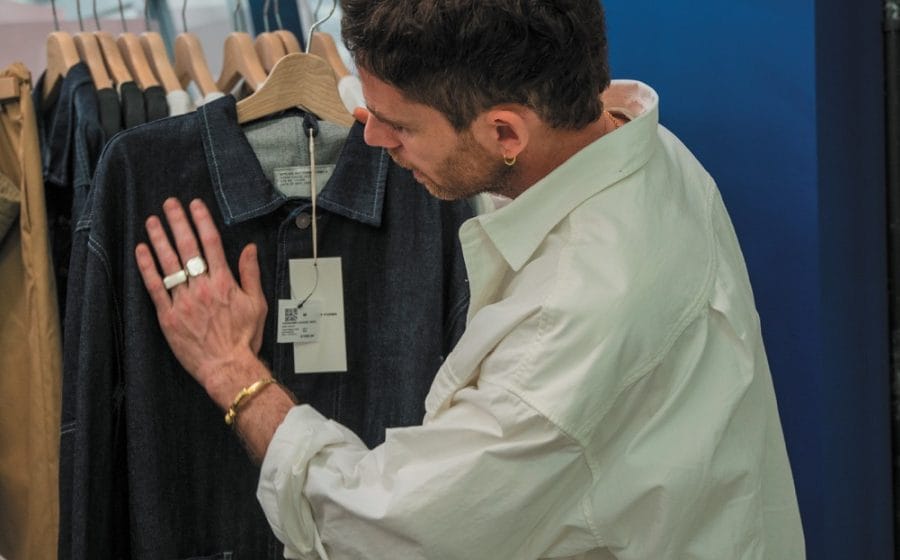Choosing a suit can be a complicated and tricky business. With salesmen persuading you with their flattery and smiles, it can be hard to decide on the right suit for your body. With a dizzying assortment of fabrics, fits and forms, ready-to-wear suits may not ultimately be right for you. Shoulders that protrude, sleeves that consume arms, and trousers that constrict the waist can be exasperating.
For a fail-safe approach, a made-to-measure suit will be the best bet. With Alfred Dunhill’s custom and bespoke services, suits are carefully altered or specifically made to the customer’s requirements. With a fully basted canvas interlining with horsehair chest canvas support, the resulting garment moulds to the curvature of the torso, providing a well-draped fit. Being responsible for Alfred Dunhill’s custom and bespoke programmes, Jonathan Payne shuttles across the world to serve his bespoke clients by personally taking measurements and fitting suits. With the likes of tailoring brands Gieves & Hawkes and Dormeuil in his CV, Jonathan Payne is a veteran with 23 years of experience in the business.
How did you get into this business of cutting and sewing?
I started off on the cloth side, by chance, in many ways. Eventually, the more I got into the cloth side, the more I loved it. It was sort of a love affair that started off by luck. The more I got into it, the more I understood about cloth and how the process works; getting it from the back of a sheep in Australia and into something woven in the UK.
What would be the difference between bespoke and custom?
What we offer in Singapore is custom, as opposed to bespoke. Custom is an extension of our ready-to-wear. It is exactly the same product, made with the same construction. Rather than something that is being pre-made or take-it-or-leave-it, it is something that we make especially for you. You have a choice of fabric, lining, style, and of course, we change the fit to fit your body. With bespoke, it is a totally different approach. We start from zero and work to create with our clients. We have greater flexibility, in terms of the styling, and greater control over the fit. The garment would be hand cut and patterned.
How do you go about guiding a client in the custom process?
Establishing what they want out of the suit is important. It is important to find out if they want it for travelling, for a special occasion or whether it is for everyday business use because that would govern what sort of cloth we would guide them towards if they are totally new to it. It is important for us to guide them in terms of their cloth selection and style, for example. We will also look at their figure type to guide them towards the style that would suit them best.
What are Asian men looking for when tailoring a suit?
Some are looking for the classic English suit. There are others who are sort of halfway. Particularly, the Chinese tend to like quite long sleeves. In the U.K. we have short sleeves as a rule. There is quite a difference but we can work with that. I can understand that maybe that is coming from wearing a Mao jacket traditionally, and liking a longer sleeve with a slightly easier fit. There are certain differences in terms of styling and fit that we can accommodate. We might also say that this is our traditional look and some people are willing to meet us halfway or some actually go for the full thing.
What do you think of the current inclination towards skinny and tapered fits and silhouettes?
The whole point of fashion is change, trying new things and experimenting. Custom does allow experimentation. I do have some customers that would ask for a shorter jacket than would normally be classically proportionate for me.

“We have the St. James fit, which is a classic English style and fit. It has the full chest, slim waist and hips. There is the Belgravia fit which is quite a slim fit. It is closer to the body. The classic English cut is for the classic English body. There are lots of Asians with a very slim build. All of us have different body shapes.”
Is there a difference between English tailoring and American tailoring?
English cut is quite particular. It is different from the American cut and the Italian cut. An English cut has quite a neat shoulder so it will fit quite closely on the shoulders without being tight, to ensure that the sleeve on the armhole fits right over the junction on the arm and torso. Traditional English cuts have a full chest and a slim, suppressed waist with slightly raised shoulders that keep the top of the sleeves very clean.
What is the first investment piece that a man should start with?
It is hard to beat a navy blue suit. They are so versatile and so easy to accessorise with shirts, ties and cufflinks. Rather than going for a completely plain blue, you might want to go with something that is a little bit textured like a herringbone, which is very smart and very elegant. Something from three metres away might look like a plain suit but actually has a bit of character to it. It is very hard to beat navy because it seems to look good for a majority of people.
What do you think sets the Alfred Dunhill suit apart from the rest?
It is a combination of cut, cloth and attention to detail. We are very fortunate to have sources of cloths from the best U.K. and Italian mills. There are some cloths that are exclusive. I am working on Spring 2013, which might feature some special imports. Behind the loophole, we have a little hand-sewn flower loop. If you might have a flower through your button hole, the actual stem would not stick out from the side. There is a little coin pocket in the trousers. Little touches such as these, which are not necessarily visible to the observer, make a difference. I think men like that; it becomes their little secret which makes it a little bit more personal.
What flexibility is there between the two fits offered?
We have the St. James fit, which is a classic English style and fit. It has the full chest, slim waist and hips. There is the Belgravia fit which is quite a slim fit. It is closer to the body. The classic English cut is for the classic English body. There are lots of Asians with a very slim build. All of us have different body shapes.
Has there been fabric innovation with the use of modern technology?
We can combine the best of traditional construction methods with the very latest technology in cloth development. Today, we have cloths that are finished with nanotechnology. It remains completely dry when a glass of red wine is spilled over. In this age, we can produce the finest gradient of wool, which will not have been possible 23 years ago when I started.










